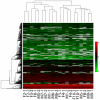Establishing the proteome of normal human cerebrospinal fluid
- PMID: 20552007
- PMCID: PMC2881861
- DOI: 10.1371/journal.pone.0010980
Establishing the proteome of normal human cerebrospinal fluid
Abstract
Background: Knowledge of the entire protein content, the proteome, of normal human cerebrospinal fluid (CSF) would enable insights into neurologic and psychiatric disorders. Until now technologic hurdles and access to true normal samples hindered attaining this goal.
Methods and principal findings: We applied immunoaffinity separation and high sensitivity and resolution liquid chromatography-mass spectrometry to examine CSF from healthy normal individuals. 2630 proteins in CSF from normal subjects were identified, of which 56% were CSF-specific, not found in the much larger set of 3654 proteins we have identified in plasma. We also examined CSF from groups of subjects previously examined by others as surrogates for normals where neurologic symptoms warranted a lumbar puncture but where clinical laboratory were reported as normal. We found statistically significant differences between their CSF proteins and our non-neurological normals. We also examined CSF from 10 volunteer subjects who had lumbar punctures at least 4 weeks apart and found that there was little variability in CSF proteins in an individual as compared to subject to subject.
Conclusions: Our results represent the most comprehensive characterization of true normal CSF to date. This normal CSF proteome establishes a comparative standard and basis for investigations into a variety of diseases with neurological and psychiatric features.
Conflict of interest statement
Figures



References
-
- Ransohoff RM. Immunology: Barrier to electrical storms. Nature. 2009;457:155–156. - PubMed
-
- Ekegren T, Hanrieder J, Bergquist J. Clinical perspectives of high-resolution mass spectrometry-based proteomics in neuroscience-Exemplified in amyotrophic lateral sclerosis biomarker discovery research. J Mass Spectrom. 2008;43:559–571. - PubMed
-
- Rozek W, Ricardo-Dukelow M, Holloway S, Gendelman HE, Wojna V, et al. Cerebrospinal fluid proteomic profiling of HIV-1-infected patients with cognitive impairment. J Proteome Res. 2007;6:4189–4199. - PubMed
-
- Sickmann A, Dormeyer W, Wortelkamp S, Woitalla D, Kuhn W, et al. Identification of proteins from human cerebrospinal fluid, separated by two-dimensional polyacrylamide gel electrophoresis. Electrophoresis. 2000;21:2721–2728. - PubMed
-
- Yuan X, Desiderio DM. Proteomics analysis of prefractionated human lumbar cerebrospinal fluid. Proteomics. 2005;5:541–550. - PubMed
Publication types
MeSH terms
Substances
Grants and funding
LinkOut - more resources
Full Text Sources
Other Literature Sources
Medical

